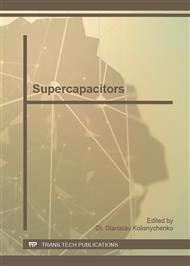[1]
V. Mancier, A. Metrot, P. Willmann. A 'transverse' ac impedance method to follow the nickel oxo-hydroxide electrode charging process. Electrochimica Acta, 2002, 47: 1633-1640
DOI: 10.1016/s0013-4686(01)00896-9
Google Scholar
[2]
Z. Chang, H. Tang, J. Chen. Surface modification of spherical nickel hydroxide for nickel electrodes. Electrochemistry Communications, 1999, 1: 513-516
DOI: 10.1016/s1388-2481(99)00098-3
Google Scholar
[3]
Y. Morioka, S. Narukawa, T. Itou. State-of-the-art of alkaline rechargeable batteries. J. Power Sources, 2001, 100: 107-116
DOI: 10.1016/s0378-7753(01)00888-6
Google Scholar
[4]
C. Lin, J. A. Ritter, B. N. Popov. Characterization of Sol-Gel derived cobalt oxide Xerogels as electrochemical capacitors. J. Electrochem. Soc., 1998, 145(12): 4097-4103
DOI: 10.1149/1.1838920
Google Scholar
[5]
Y. Mo, M. R. Antonio, D. A. Scherson. In Situ Ru K-Edge X-Ray Absorption Fine Structure Studies of Electroprecipitated Ruthenium Dioxide Films with Relevance to Supercapacitor Applications. J. Phys. Chem. B, 2000, 104 (42): 9777-9779
DOI: 10.1021/jp002355a
Google Scholar
[6]
J. P. Zheng, T. R. Jow. A new Charge storage mechanism for electrochemical capacitors. J. Electrochem. Soc., 1995, 142(1): L6-L8
DOI: 10.1149/1.2043984
Google Scholar
[7]
J. P. Zheng. Ruthenium oxide carbon composite electrodes for electrochemical capacitors. Electrochem. Solid State Lett., 1999, 2(8): 359-361
DOI: 10.1149/1.1390837
Google Scholar
[8]
J. Jiang, A. Kucernak. Electrochemical supercapacitor material based on manganese oxide: preparation and characterization. Electrochimica Acta, 2002, 47: 2381-2386
DOI: 10.1016/s0013-4686(02)00031-2
Google Scholar
[9]
B. Messaoudi, S. Joiret, M. Keddam, H. Takenouti. Anodic behaviour of manganese in alkaline medium. Electrochimica Acta, 2001, 46: 2487-2498
DOI: 10.1016/s0013-4686(01)00449-2
Google Scholar
[10]
H. Y. Lee, J. B. Goodenough. Ideal supercapacitor behavior of amorphous V2O5·nH2O in potassium Chloride aqueous solution. Solid State Chem., 1999, 148: 81-84
DOI: 10.1006/jssc.1999.8367
Google Scholar
[11]
K.-C. Liu, M. A. Anderson. Porous nickel oxide/nickel film for electrochemical capacitors. J. Electrochem. Soc., 1996, 143(1): 124-130
DOI: 10.1149/1.1836396
Google Scholar
[12]
V. Srinivasan, J. W. Weidner. An electrochemical route for making porous nickel oxide electrochemical capacitors. J. Electrochem. Soc., 1997, 144(8): L210-213
DOI: 10.1149/1.1837859
Google Scholar
[13]
J. P. Zheng, P. J. Cygan, T. R. Jow. Hydrous Ruthenium oxide as an electrode material for electrochemical capacitors. J. Electrochem. Soc., 1995, 142(8): 2699-2703
DOI: 10.1149/1.2050077
Google Scholar
[14]
K.-W. Nam, K.-B. Kim. A Study of the Preparation of NiOx Electrode via Electrochemical Route for Supercapacitor Applications and Their Charge Storage Mechanism. J. Electrochem. Soc., 2002, 149(3): A346-354
DOI: 10.1149/1.1449951
Google Scholar
[15]
S.-C. Pang, M. A. Anderson, T. W. Chapman. Novel Electrode Materials for Thin-Film Ultracapacitors: Comparison of Electrochemical Properties of Sol-Gel-Derived and Electrodeposited Manganese Dioxide. J. Electrochem. Soc., 2000, 147(2): 444-450
DOI: 10.1149/1.1393216
Google Scholar



